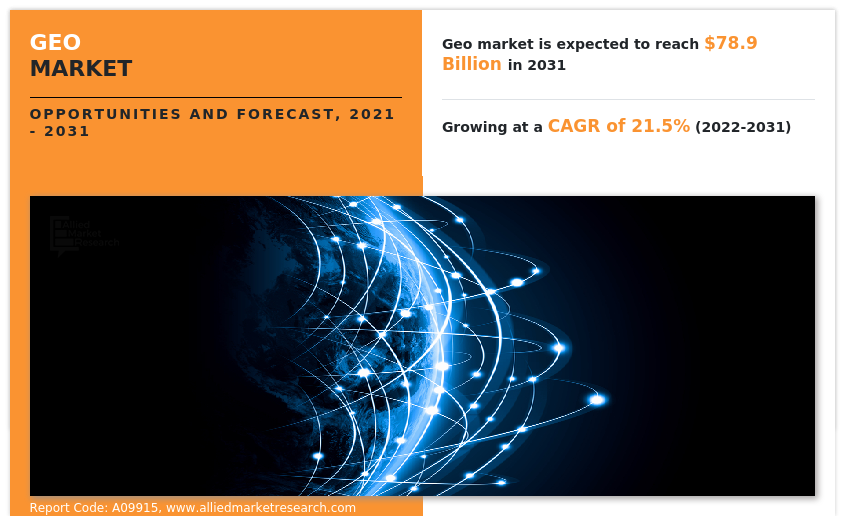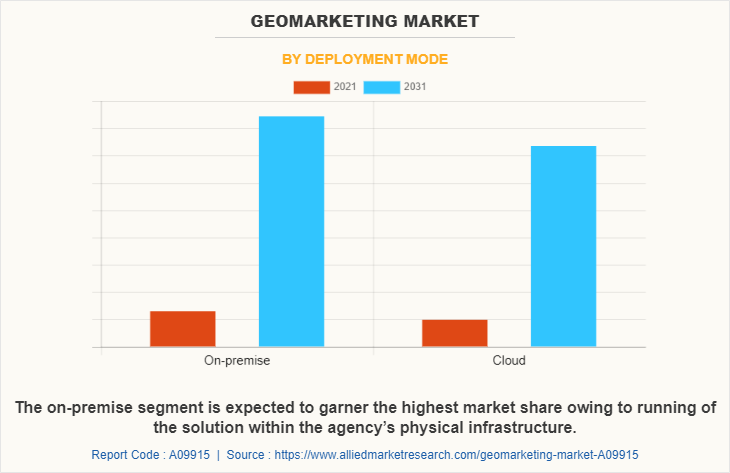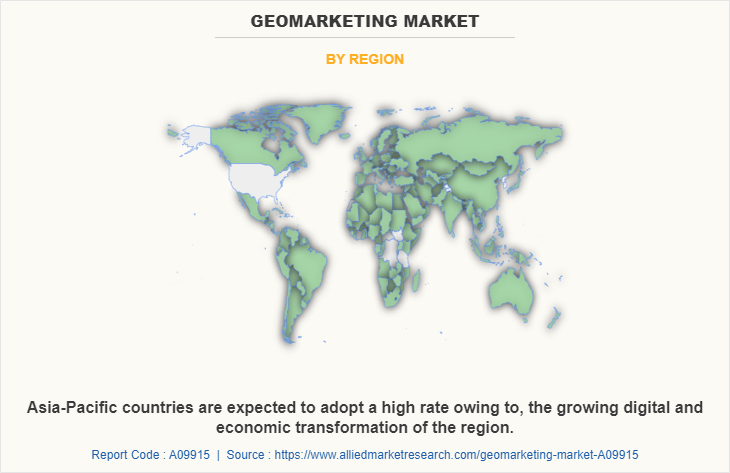Geomarketing Market Research, 2031
The global geomarketing market size was valued at $11.4 billion in 2021, and is projected to reach $78.9 billion by 2031, growing at a CAGR of 21.5% from 2022 to 2031.
Growing investment in digital marketing compared to conventional marketing and increasing demand for location-based intelligence are boosting the growth of the global geomarketing market. In addition, enhance customer targeting with the help of AI, Location analytics, and big data positively impacts geomarketing market growth. However, legal concerns & data privacy threats and lack of skilled operators are hampering the market growth. On the contrary, high demand for mobile computing and treading social media is expected to offer remunerative opportunities for expansion of the market during the forecast period.

Geomarketing is a form of marketing that uses location data to target advertising and promotions to reach consumers with appropriate messaging in particular localities. The applications of geomarketing, and lots of reasons such as to improve business reach in certain areas or among certain targeted audiences. Furthermore, geomarketing tools are also adopted for purpose such as audience targeting, location targeting, and weather targeting. The geomarketing market is segmented into Offering, Deployment Mode, Industry Vertical, Location Type and Enterprise Size.
Segment Review
The global geomarketing market is segmented based on offering, deployment mode, location type, enterprise size, industry vertical and region. By offering, the market is bifurcated into solution and service. By service type, the market is bifurcated into professional services, managed services. By professional services, the market is further divided into training & education, integration & deployment, and support & maintenance. By deployment model, the market is segmented into on-premises and cloud based. By location type, it is categorized into outdoor and indoor. By industry vertical, the market is divided into BFSI, IT and telecom, retail and ecommerce, travel and hospitality, construction, and real-estate, automotive and transportation, and others. Region-wise, it is analyzed across North America, Europe, Asia-Pacific, and LAMEA.
The key players profiled in the geomarketing market analysis are Adobe, Cisco Systems, Inc., CleverTap, ESRI, Galigeo, Google LLC., HYP3R, Inc., IBM, Microsoft, Oracle, PlotProjects, Qualcomm Technologies, Inc., Saksoft, Salesforce, Inc., Software AG, Telefonaktiebolaget LM Ericsson, and Xtremepush. These players have adopted various strategies to increase their market penetration and strengthen their position in the geomarketing industry.
In terms of deployment model, on premises segment holds the largest share of the geomarketing market, owing to the increased adoption as it enables fast & accurate decisions regarding software issues and help to enhance competitiveness among small- & medium-sized enterprises. However, the cloud segment is expected to grow at the highest rate during the forecast period, owing to increase in need to reach different clients on demand and enable multiple users to access geospatial technology has led to surge in adoption of cloud-based geomarketing solutions.

Region wise, the geomarketing market share was dominated by North America in 2021 and is expected to retain its position during the forecast period, owing to rise in investment in the defense sector and technological advancements in the telecommunication industry acts as the key driving forces of the geomarketing market in North America. However, Asia-Pacific is expected to witness significant growth during the forecast period, owing to rapid digitalization during the COVID-19 pandemic & rise in popularity location-based solutions among the retailers, transportation services and others in the region.

The report focuses on growth prospects, restraints, and trends of the global geomarketing market analysis. The study provides Porter’s five forces analysis to understand impact of various factors, such as bargaining power of suppliers, competitive intensity of competitors, threat of new entrants, threat of substitutes, and bargaining power of buyers, on the global augmented reality in retail market share.
Top Impacting Factors
Growing investment in digital marketing compared to conventional marketing
Organizations is switching from traditional marketing tools to digital platforms as a result of the development in digital transformation since the latter provide more affordability and efficient client interaction. Moreover, Print and television advertising are both more expensive and less effective than using internet marketing techniques. Therefore, organizations are able to choose a lucrative approach for companies through digital marketing channels with the targeted research and analytics.
For instance, in October 2020, IBM introduced three new products to add to its growing suite of AI solutions for brand and publishers. The new capabilities are privacy-forward and designed to allow brands to reach consumers while considering user privacy. Additionally, making intelligent, data-based decisions is made easier for clients by the IBM Watson advertising suite of tools. Expanding to the suite's most recent upgrades, which include Watson advertising accelerator and Watson advertising social targeting. Furthermore, as a result digital solutions are more effective in marketing organizations, resulting in significant market growth.
Increasing demand for location based intelligence
Increasing demand for location-based services, technological advancements, and increase in use of smartphones/GPS-enabled devices and rise in adoption of business intelligence are the factors driving growth of the global geomarketing market. Moreover, due of its superior navigation and tracking capabilities, location-based services including mapping, navigation, geographic information systems, and emergency response services are preferred by end users. Therefore, the geomarketing services and solutions are driven by these key factors across a variety of sectors, including BFSI, education, retail manufacturing, transportation, and others.
For instance, in February 2020, Phunware, Inc., a fully integrated enterprise cloud platform for mobile that provides products, solutions, data and services for brands worldwide announced that Cisco Meraki now features the company’s Multiscreen-as-a-Service (MaaS) location-based services (LBS) app in its Meraki marketplace. Furthermore, such innovations influencing the rising growth of location-based intelligence in geomarketing industry.
COVID-19 Impact Analysis
The global geomarketing market has witnessed stable growth during the COVID-19 pandemic, owing to the increased in digital penetration during the induced lockdowns and stringent social distancing policies, which further fueled the demand for remote operational tools such as geomarketing services. In addition, the growing adoption of location-based services by various sectors, including manufacturing, transportation, government agencies, energy, natural resource management, and e-retail owing to the covid restrictions.
Moreover, according to an article published by United Nation Conference on Trade and Development (UNCTAD), in March 2021, COVID-19 has led to a surge in e-commerce and accelerated digital transformation. Lockdowns has created opportunities for both providers and consumer offering and buying more products and services online. As a result, e-commerce share of global retail trade increased from 14% in 2019 to over 17% in 2020. Furthermore, increasing number of COVID-19 cases, is resulting in organizations to adopt digital platforms. Advancements in digitalization drives the importance for location-based services due to its ability to provide customized marketing strategy services. Such factors propelled the growth of the global geomarketing market during the period.
Key Benefits For Stakeholders
- This report provides a quantitative analysis of the geomarketing market forecast, current trends, estimations, and dynamics of the geomarketing market analysis from 2021 to 2031 to identify the prevailing geomarketing market opportunities.
- The market research is offered along with information related to key drivers, restraints, and opportunities.
- Porter's five forces analysis highlights the potency of buyers and suppliers to enable stakeholders make profit-oriented business decisions and strengthen their supplier-buyer network.
- In-depth analysis of the geomarketing market segmentation assists to determine the prevailing market opportunities.
- Major countries in each region are mapped according to their revenue contribution to the global market.
- Market player positioning facilitates benchmarking and provides a clear understanding of the present position of the market players.
- The report includes the analysis of the regional as well as global geomarketing market trends, key players, market segments, application areas, and market growth strategies.
Geomarketing Market Report Highlights
| Aspects | Details |
| Market Size By 2031 | USD 78.9 billion |
| Growth Rate | CAGR of 21.5% |
| Forecast period | 2021 - 2031 |
| Report Pages | 343 |
| By Offering |
|
| By Deployment Mode |
|
| By Industry Vertical |
|
| By Location Type |
|
| By Enterprise Size |
|
| By Region |
|
| Key Market Players | Saksoft, Microsoft, Qualcomm technologies, inc., IBM, Hyp3r, inc., Software Ag, Salesforce, inc., Adobe, Telefonaktiebolaget Lm Ericsson, Oracle, Esri, Google llc., Clevertap, Cisco systems, inc., Xtremepush |
Analyst Review
The more and more diverse data and web technologies are creating potential growth opportunities for the Geomarketing market. Geomarketing offers various benefits such as spatial analysis, rationalization, and objectification of decision-making processes, generate added value for users data, identify relationships more easily, and supporting company processes. The reliability of such benefits drives the growth of the Geomarketing market. Furthermore, Geomarketing can be used for targeting mobile and social media users by using techniques such as social check-ins to create more respective offers. It can be easy to engage the audience with quality, relevant content that targeted customers need for their respective areas. The demand for geomarketing solutions is increasing due to the improvement of the business decision for customer targeting.
Key providers of geomarketing market such as Microsoft, IBM and Oracle corporation. account for a significant share in the market. With the larger requirement from the corporate culture, various brands are expanding business outlets to automate and simplify data management. For instance, in February 2022, Google announced product development plans to bring its Privacy Sandbox initiatives to Android in a bid to expand its privacy-focused, but also less disruptive, advertising technology beyond the desktop web.
In addition, with the increasing demand for getting instant solutions to the problem with all the resourceful insights companies such as IBM has performed strategic acquisition to help the end users. For instance, in October 2021, IBM announced plans to acquire the Adobe Workfront consulting unit and assets from Rego Consulting Corporation to further its hybrid cloud and AI strategy. This acquisition helps to enhance business transformation expertise to automate marketing workflows with AI.
Furthermore, in June 2022, Softbank-backed InMobi, a provider of content, marketing, and monetisation technologies, announced an expansion of its partnership with Microsoft Advertising to support enterprise and strategic advertisers in Southeast Asia, West Asia, and Africa. InMobi will offer marketers an integrated solution to power their campaigns built on the search and native display capabilities of Microsoft Advertising.
Growing investment in digital marketing compared to conventional marketing and increasing demand for location-based intelligence are boosting the growth of the global geomarketing market.
Region wise, the geomarketing market was dominated by North America in 2021 and is expected to retain its position during the forecast period, owing to rise in investment in the defense sector and technological advancements in the telecommunication industry acts as the key driving forces of the geomarketing market in North America.
The global geomarketing market size was valued at $11.37 billion in 2021, and is projected to reach $78.9 billion by 2031, growing at a CAGR of 21.5% from 2022 to 2031.
The key players profiled in the geomarketing market analysis are Adobe, Cisco Systems, Inc., CleverTap, ESRI, Galigeo, Google LLC., HYP3R, Inc., IBM, Microsoft, Oracle, PlotProjects, Qualcomm Technologies, Inc., Saksoft, Salesforce, Inc., Software AG, Telefonaktiebolaget LM Ericsson, and Xtremepush. These players have adopted various strategies to increase their market penetration and strengthen their position in the industry.
Loading Table Of Content...



